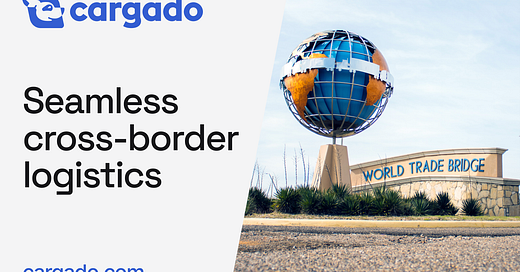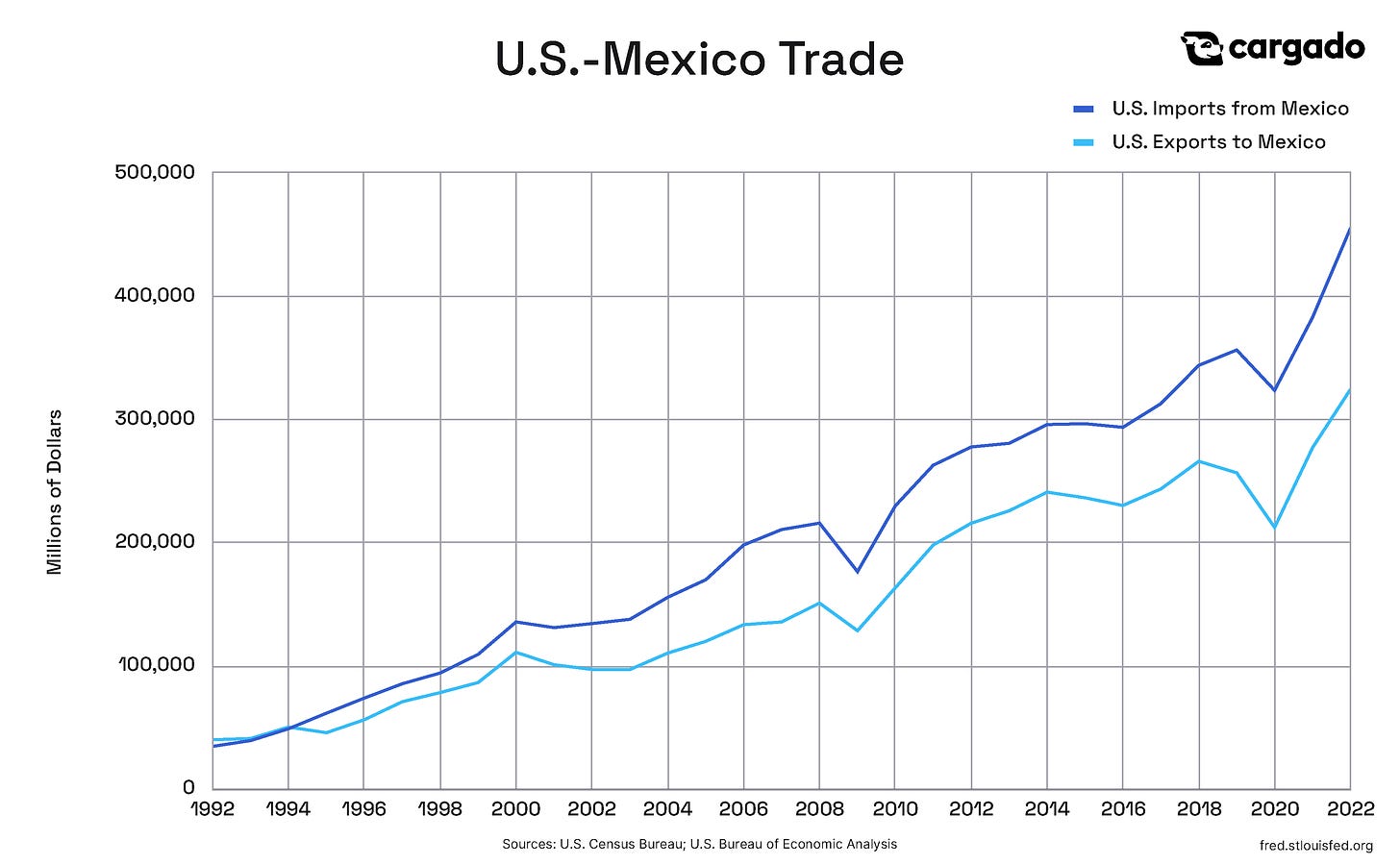Issue #9: Introducing Cargado
I’m proud to announce that Cargado is out of stealth, with a $3M round from Ironspring Ventures, Wischoff Ventures, Zenda Capital, Proeza Ventures, Sahil Bloom, Craig Fuller, & other angel investors.
Background
It was nearly ten years ago that I first dabbled in cross-border Mexico freight, a story I recently told in Issue #6: How I got my start with Mexico. Mexico has been on my mind ever since that first trip to Laredo, TX.
Fast forward through my time starting Coyote’s Mexico business, building and selling Forager, and integrating it with Arrive Logistics, and we come to today, when we finally start to pull back the curtain on my next project, Cargado.
Nearshoring is Booming
If you haven’t ever read a post from me on LinkedIn, X, or Substack, then you haven’t heard me talk about how much trade is growing between the United States and Mexico. In fact, I devoted an entire post just covering nearshoring, Issue #2: Nearshoring is Booming. To recap parts of that post, let’s review:
The Global COVID Pandemic shut down the world and forced companies to rethink their supply chains. Similar labor costs in Mexico with significant benefits given the proximity has resulted in companies moving manufacturing from Asia to Mexico.
The U.S.-China Trade War is driving a deeper divide between the two countries and companies are employing friendshoring in addition to nearshoring – relying more on a friendlier country like Mexico.
The USMCA drove automotive production closer to home too – increasing the number of parts that need to be produced in North America from 62.5% to 75%.
The Suez Canal has had two major disruptions in the past three years. When I wrote that newsletter back in early December, we hadn’t even experienced the most recent challenges with attacks on ships passing through the Suez Canal.
Brexit made trade with the EU a bit more challenging, giving U.S. companies even more incentives to focus on deals with Mexico.
The semiconductor chip shortage caused big concerns among manufacturers of smartphones, computers, cars, all types of electronics, and so many other products that rely on these complex chips. They can’t just be made anywhere, and the U.S. government is working hard to incentivize companies to produce chips in North America through the CHIPS act.
Over the past decade alone, trade between the United States and Mexico has seen remarkable growth, expanding by 58%, from $493 billion in 2012 to $779 billion in 2022. With companies like Tesla, Mattel, Unilever, and Kia Motors investing billions of dollars collectively in their manufacturing footprint in Mexico, we’re just at the tip of the iceberg when it comes to demand in Mexico.
What’s the impact from all this nearshoring?
We’re going to see a lot of growth in U.S.-Mexico logistics. Logistics companies are quickly expanding into Mexico – we saw it when Arrive bought Forager and we’ve seen several other companies make strategic acquisitions to expand services into Mexico, or hire experienced leaders who can build a Mexico service offering.
More and more manufacturers are increasing their production in Mexico and need more support for their cross-border operations. The processes involved in these operations are severely outdated and working with legacy systems that weren’t built for managing this type of freight.
Carriers who move cross-border freight also play a critical role in this expanding market and, like logistics service providers and customs brokers involved in the process, have long operated off of tribal knowledge and relationships, something that won’t go away but needs to evolve.
We’re going to see new products coming out of Mexico that previously came in through the port of Long Beach, and we’ll see volume increase out of most major markets in Mexico along with volume flowing through all the major border cities.
There’s one huge issue with all this growth.
The systems in use today cannot support this growth. There are very few standards, very few tools, and very few innovations in this space. We plan to address a lot of these issues with the technology we’re going to build at Cargado.
While I’m not going to outline our roadmap today, I want to make two things crystal clear: we are not building a brokerage and we are not here to disrupt cross-border supply chains. They’re way too fragile and complex to break. We have a deep understanding of the challenges that exist in every aspect of this process and believe that there are better ways to manage these processes and support these relationships.
So who is ‘we’?
I spent a lot of time looking for a technical co-founder after leaving Arrive. I met some incredibly talented technical leaders but it wasn’t until I was introduced to Rylan Hawkins that I knew I had found my match. Rylan has a really unique background, having spent time playing collegiate and professional soccer (three months with the New England Revolution!) before deciding he wanted to start a tech career and joined Microsoft. He spearheaded the Windows search integration of Bing and led the team building the internalization platform for Windows 8 applications, which shipped to over 1 billion customers.
He then joined Convoy in 2016 as one of the first engineers and eventually grew to become General Manager of two of Convoy’s most successful programs – Convoy Go and Convoy for Brokers — which generated a combined $300M in gross revenue and fostered a deeper level of insight on the potential for logistics technology innovation.
Back in October, I flew out to Seattle shortly after Convoy closed its doors to try and recruit Rylan and some engineers who had been at Convoy. Every engineer I met said they would follow Rylan wherever he went. We had to narrow the group to three in order to launch Cargado without over-hiring right out of the gate. I’m excited that Steven Wojcio, Jonathan Witten, and Teagan Horkan joined the team as they all have amazing backgrounds and have already contributed greatly to the early technical decisions made as we start building the product.
Our Backers
This team goes deeper than me, Rylan, and our three engineers. We raised a $3M pre-seed round from an incredible group of investors who are all passionate about logistics, supply chain, and LatAm.
Our lead investor, Ty Findley at Ironspring Ventures, has done several other deals in our category in his career, including FreightWaves, Project44, OneRail, and Solvento.
Esteban Reyes at Zenda Capital, previously a fintech founder who launched his own fund, has a deep focus on both supply chain and logistics, having invested in OneRail and Solvento.
Nichole Wischoff, solo GP and founder of Wischoff Ventures, has operating experience and a vast network, with investments in companies like Loop, among so many other startups.
We also welcomed Proeza Ventures, who backed Forager, and focuses on all things mobility, logistics, and LatAm. (and they also invested in Solvento with Ironspring and Zenda… sensing a theme?)
Sahil Bloom, was also in the deal and has been a huge help in how I’ve started to develop my social media presence.
Craig Fuller, founder and CEO of FreightWaves, and a close friend and mentor of mine, headlines an incredible list of over twenty-five entrepreneurs and operators, smart people who have built 9-figure businesses, who invested their capital and have also invested their time supporting our new venture. I’ve been fortunate to make several angel investments in the past few years and am excited to have some incredible angel investors at the table this time around.
What’s next?
We’re committed to building tools and resources that we believe the industry deserves. We’ve learned a lot from our collective time at industry-defining companies like Coyote, Convoy, Forager, and Arrive Logistics, along with technology titans like Google and Microsoft. We fundamentally believe that the world needs a more connected supply chain.
We already have a group of really strong beta customers who are going to start using the product and sharing feedback soon. Once we feel confident our product delights our beta users, we’ll open up the product to more companies.
If you’re involved in cross-border freight, you can learn more about Cargado and join the waitlist at cargado.com. I’ll continue to write about the journey of building Cargado, along with how things are evolving in cross-border freight and all things freight tech, so go ahead and subscribe to this newsletter once you finish reading this sentence:






Love this Matt ! Thank you